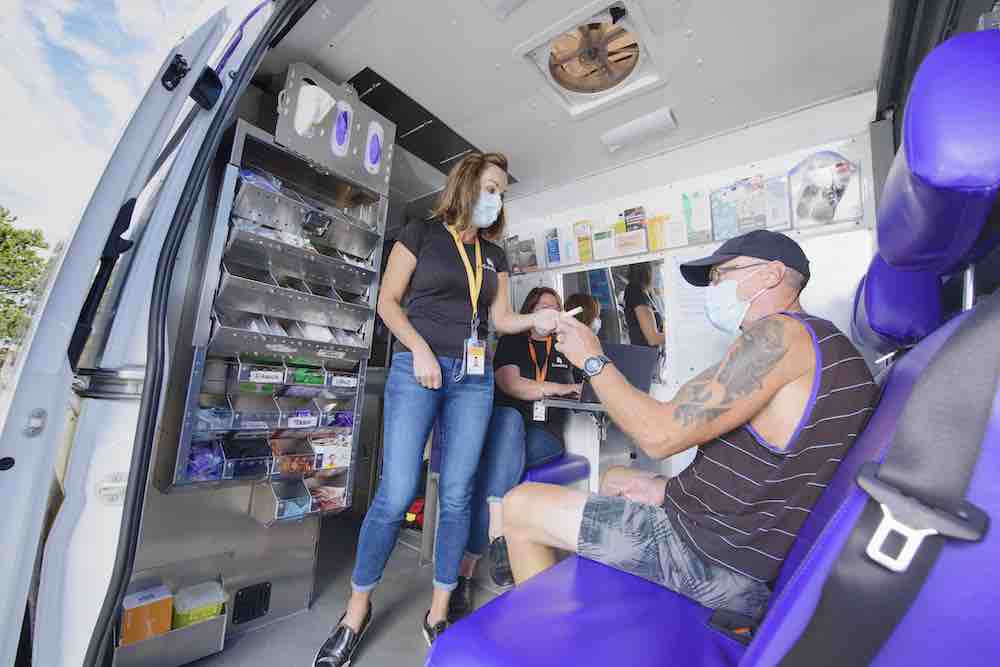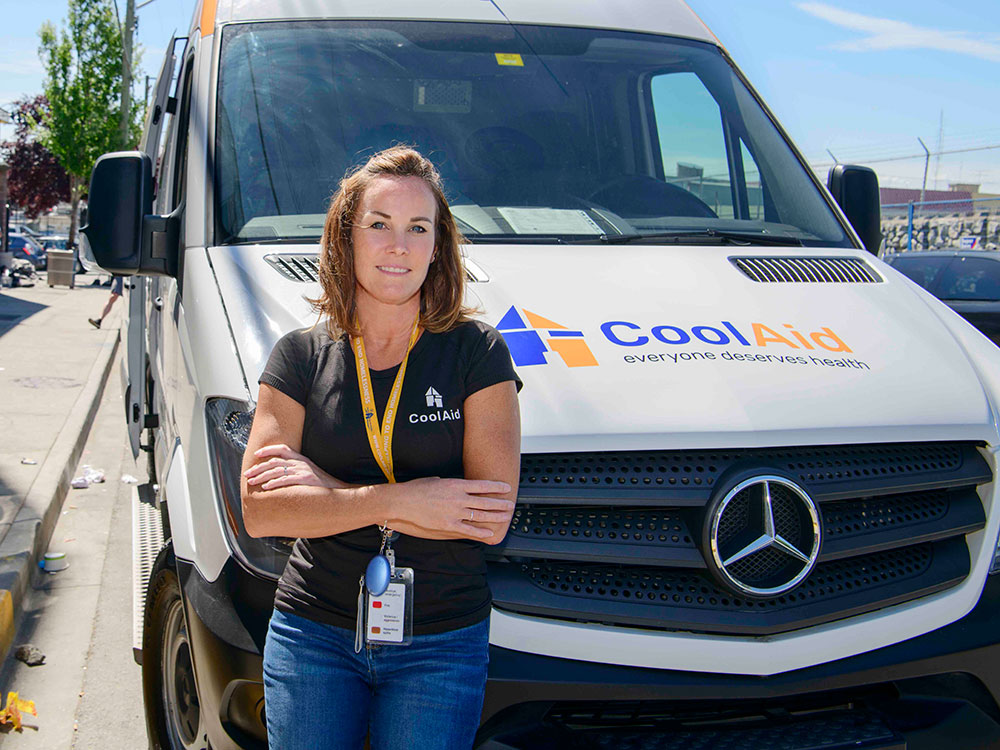Community health centres offer one-stop access to care and supports, say proponents.
Karen Lundgren says the community health centre where she works in downtown Victoria is the kind of place she’d want to receive medical care.
“It’s the best way to do health care,” Lundgren said. “I would love to go to my family doctor and have access to a physio there, counselling there, you know like a one-stop shop. It’s not the norm and it needs to be.”
Lundgren is the manager of the nursing team at Victoria Cool Aid Society’s community health centre and she runs the organization’s outreach sites and mobile health clinic. A non-profit that also provides housing and runs a dental clinic, Cool Aid targets its services to people who are impacted by poverty, colonization, stigma and homelessness.
The health clinic is one of 31 members of the BC Association of Community Health Centres. Other clinics in the association serve various populations, with some specializing in caring for Indigenous people, immigrants or seniors, or on a particular neighbourhood or region.
The provincial government has for years promised to increase the number of community health centres and better support them. But progress has been slow.
Following through on that commitment would be good for patients, health-care workers and the overall system, said Lundgren.
“There’s a real collaboration within the multidisciplinary team,” she said. “So we’re a team of doctors, nurses, medical office assistants, pharmacists, pharmacy assistants, acupuncturists, counsellors, help outreach workers, nurse practitioners, physio, and we collaborate very, very closely.”
The model works well for patients, but also for the providers, she said. While health-care worker stress and burnout has been one of the stories of the COVID-19 pandemic, the community health centre has not seen it to the same degree.

‘Created by and for community’
Despite working with a patient population that has complex health needs, said Lundgren, staff at the Cool Aid clinic enjoy a lot of autonomy and work to the full scope of their disciplines, making it much more satisfying than many other jobs in health care.
If nurses, and the physicians who work with them, know the full range of what nurses can take on, it also eases pressure on other providers and increases the capacity of the clinics where they work, Lundgren said. “Nurses can do all kinds of assessments independently and I think that would increase access for clients if nurses work at their full scope.”
Some of the other community health centres operating in the province include ones run by REACH and RISE in Vancouver, the Community First Health Co-op in Nelson and half a dozen across the Gulf Islands.
In Vancouver, REACH on Commercial Drive has “an increased focus on immigrants, reflecting the multicultural makeup of our community.” The Central Interior Native Health Society’s primary health-care clinic is dedicated to Indigenous health. A clinic at Luther Court in Victoria makes its services available to people in particular neighbourhoods. RISE gives priority to “Renfrew-Collingwood residents who do not have a regular health-care provider and experience barriers to accessing care.”
While the centres are diverse in who they care for and how they do it, they are all created by not-for-profit organizations or co-operatives to deliver integrated services and programs that reflect their communities’ needs and priorities, said BC Association of Community Health Centres’ executive director Valerie St. John.
They use a collaborative team approach to provide comprehensive, accessible, affordable and culturally appropriate services, she said. “They are all different because they serve different community needs,” but all of them are “created by community for community, and they’re governed that way.”
It’s a model that Health Minister Adrian Dix and the NDP have long said they want to expand.
Amidst doctor shortages, community health centres can help
In 2018 when Dix and then-premier John Horgan announced the government’s primary care strategy it included more support for non-profit community health centres to “bring together health and broader social services to improve access to health promotion, preventive care and ongoing services.”
And even before forming government, the NDP had promised to “fully capitalize” on community health centres to improve public health care and provide better access to primary care.
In a 2017 pre-election letter to the BC Association of Community Health Centres, it pledged to add 20 new community health centres and to provide the existing ones with more stable funding.
“Delivering primary health care through integrated, multi-disciplinary teams across urban and rural B.C. is a principal part of our plan for improving access to safe timely quality care, improving health and community outcomes, and reducing pressure on ERs, acute care hospital beds and residential care,” it said.
“Supporting and sustaining existing community health centres, and replicating their successes is integral to our platform commitment to make team based primary care the standard across B.C.”
But the association’s St. John said that while the promise of 20 new community health centres was achievable, just seven new ones have opened since the NDP formed government.
With roughly a million British Columbians lacking access to a family doctor or other primary care provider, the government has instead focused on attaching patients to primary care and opening urgent and primary care centres, which are also physician-centred, St. John said.
The direction has ignored how community health centres can help, she said, noting that some 80,000 patients are already attached to community health centres and make about 150,000 visits a year to the centres.
No global funding model
There’s no need to reinvent team-based care in doctor’s offices and there’s no question more communities want community health centres, St. John said. The association is working with 14 that would like to open community health centres and there are half a dozen proposals in front of government officials waiting for decisions.
Aside from the wait for new community health centres to win approval and support from the government, there’s a need to improve core funding for the existing centres, said St. John.
There’s a move towards funding community health centres through the government’s primary care networks “of providers and clinicians who come together to plan for and deliver all of the primary care needs of a community.”
But that doesn’t allow for services outside of primary care that many centres provide, such as addressing food security or housing.
As many as six ministries have programs that could run through community health centres, but delivering those services is done in an unco-ordinated way, she said. Funding needs to be integrated, she added, with different government ministries collaborating to support the variety of services the centres offer.
“They all struggle because there is no global funding model,” St. John said, adding that centres end up cobbling together funding from various sources, including community fundraising and contracts based on particular community needs.
The government has yet to deliver fully on its 2017 election promise, she said.
And yet St. John said she’s hopeful about what she’s been hearing from Dix and health officials recently. “We’re moving in a good direction,” she said. “We’ve been involved in a lot of good conversations with the ministry, which we appreciate.”
Dix says he’s still a fan of the model. A significant number of community health centres have been created since the government came to office, including some that are Indigenous-led and the foundation is in place to quickly create more.
“My view is we’re going to have numbers such as 20 well in the rear view very soon,” Dix said in a late March interview. “That number will grow significantly in the next period. The reason I think it will grow significantly is that the profound change that I was talking about for at least a decade prior to the 2017 election in [the] fee-for-service model that we’ve now undertaken.”
Last October the government reached an agreement with the Doctors of BC that included payment for the number of hours a physician works and for how many patients they are caring for, including amounts that vary depending on how complex the patients’ needs are.
Previously about 80 per cent of primary care in B.C. was paid for through a fee-for-service model where doctors are paid a flat rate for each service they provide, regardless of how long it takes.
“The new model to pay doctors supports community health centres,” Dix said. “I expect that model to become more and more the prevalent model in B.C. health care and the system will be the better for it.”
The government has also been providing consistent financial support for community health centres since 2017 along with support for the BCACHC umbrella group, he said. It has introduced primary care networks and is building out team-based care in a way that benefits community health centres, he added.
“All of this is transformational for the primary care system and it’s going to lead to more and more community health centres,” Dix said. “That’s an intended consequence of the strategy.”
At the same time, he said, there’s only so much he and the government can do. “Community health centres have to come from the community,” he said. “When I hear about them, I support them.”
Dix gave a similar answer at a March 16 event, stressing that he and the ministry need to listen to what communities want. “A community health centre is developed in the community,” he said. “Why is there one in Renfrew-Collingwood? Because the community made a proposal approved by the Ministry of Health, and it’s going ahead. Why did Lu’ma start? For the same reason.”
When Mary Chudley was told about Dix’s comment that he can’t create the proposals for community health centres himself, she had a ready answer.
“I’ll do it,” she said. “Tell him that.”





